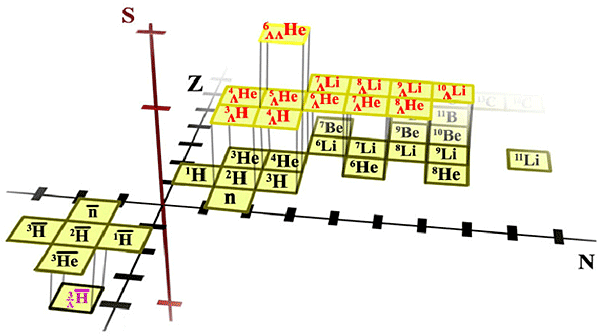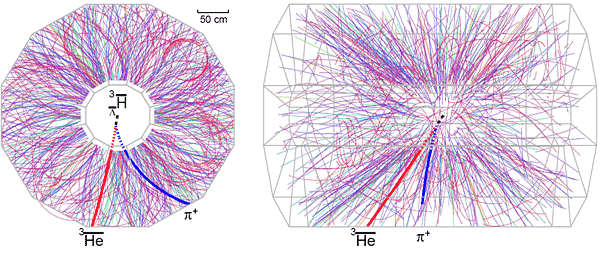STAR Reports Discovery of Heaviest Known Antimatter Nucleus and First Antinucleus Containing an Anti-Strange Quark
March 8, 2010
By Jinhui Chen, Hank Crawford, Declan Keane, Hao Qiu, Zebo Tang, and Zhangbu Xu
In the 328 issue of the journal Science [1] and its Issue Highlights Science Express available online on March 4, the STAR collaboration has published evidence of the most massive antinucleus discovered to date. The new antinucleus is a negatively charged state of antimatter containing an antiproton, an antineutron, and an anti-Lambda particle. It is also the first antinucleus containing an anti-strange quark.
All terrestrial nuclei, made of protons and neutrons (which in turn contain only up and down quarks), have a zero value for the quantum number ‘strangeness’. The strangeness could be non-zero in the core of collapsed stars, so the present measurements will help us distinguish between models that describe these exotic states of matter [2]. Since the discovery of hypernuclei in 1952, many major laboratories have dedicated experiments for hypernuclear studies, with on-going and future facilities at GSI and MAMI C in Germany, DANE in Italy, J-PARC in Japan, JINR in Russia, and JLab in the US.

The diagram above is known as the 3-D chart of the nuclides. The familiar Periodic Table arranges the elements according to their atomic number, Z, which determines the chemical properties of each element. Physicists are also concerned with the N axis, which gives the number of neutrons in the nucleus. The third axis represents strangeness, S, which is zero for all naturally occurring matter, but could be non-zero in the core of collapsed stars. Antinuclei lie at negative Z and N in the above chart, and the newly-discovered antinucleus now extends the 3-D chart into the new region of strange antimatter.
The findings also pave the way towards exploring violations of fundamental symmetries that occurred in the early universe, making possible the very existence of our world. Collisions at RHIC fleetingly produce conditions that existed a few microseconds after the Big Bang. In both nuclear collisions and in the Big Bang, which started the universe as we know it, quarks and anti-quarks emerge with equal abundance. At RHIC, among the collision fragments that survive to the final state, matter and antimatter are still close to equally abundant, even in the case of the relatively complex antinucleus and its normal matter partner featured in the present study. In contrast, antimatter appears to be largely absent from the present-day universe.
Understanding precisely how and why there is a predominance of matter over anti-matter remains a major unsolved problem of physics. A solution will require measurements of subtle deviations from perfect symmetry between matter and antimatter, and there are good prospects for future antimatter measurements at RHIC to address this key issue. Furthermore, the present discovery demonstrates that the anti-nucleus production mechanism known as statistical coalescence holds over a wider range of conditions than had previously been tested. This in turn has implications for novel ideas related to the structure of nuclear matter [3] and for cosmic ray experiments searching for new physics like Dark Matter [4].
About a hundred million collisions between gold nuclei were scanned in the antimatter analysis, with the new antinucleus being identified via its characteristic decay into a light

isotope of anti-helium and a positively charged pion meson (see the display of the emitted particles detected in the main cylindrical tracking chamber of the STAR experiment, shown from the end and from the side). Altogether, 70 examples of the new anti-nucleus were found.
Recent theoretical studies motivate a search for the onset of Quark Gluon Plasma by studying the evolution of the baryon-strangeness correlation as a function of collision energy [5]. Our measurements provide a natural and sensitive tool to extract this correlation since the coalescence process for an (anti-)hypernucleus requires its constituents (Lambda and nucleons) to be in proximity in phase space. The results indicate that the phase space population for strangeness is very similar to that for light quarks at RHIC, in contrast to the situation at the AGS. In 2010, RHIC will begin a systematic scan over beam energies ranging from low values (near AGS energies) on up to the top RHIC energy. Although anti-hypernucleus production and RHIC luminosity both decrease dramatically towards lower beam energy, the coalescence probability for hypernucleus production increases, largely compensating for the decreasing luminosity [6]. This scan should allow the trend with collision energy to be determined more accurately, and should lead to quantitative comparisons with models.
The STAR collaboration is composed of 54 institutions from 13 countries: Brazil, PR China, Croatia, the Czech Republic, France, Germany, India, Korea, the Netherlands, Poland, Russia, the United Kingdom as well as the US. STAR is poised to resume antimatter studies at top RHIC energy with greatly enhanced capabilities, and expects to increase its data by about a factor of 10 in the next few years, allowing even heavier exotic nuclear states to be discovered and studied.
[1] B. I. Abelev et al. (STAR Collaboration) Science 328 (2010).
[2] J. M. Lattimer and M. Prakash, Science 304, 536 (2004).
[3] W. Greiner, Int. J. Mod. Phys. E 5, 1 (1996).
[4] S. Ahlen et al., Nucl. Instrum. Methods A 350, 351 (1994); F. Donato, N. Fornengo, D. Maurin, Phys. Rev. D 78, 043506 (2008).
[5] V. Koch, A. Majumder, J. Randrup, Phys. Rev. Lett. 95, 182301 (2005); A. Majumder, B. M¨uller, Phys. Rev. C 74, 054901 (2006); R. V. Gavai, S. Gupta, Phys. Rev. D 73, 014004 (2006).
[6] P. Braun-Munzinger, J. Stachel, Nature 448, 302 (2007); B. I. Abelev, et al. STAR Note SN0493:
http://drupal.star.bnl.gov/STAR/starnotes/public/sn0493
2010-1670 | INT/EXT | Newsroom









